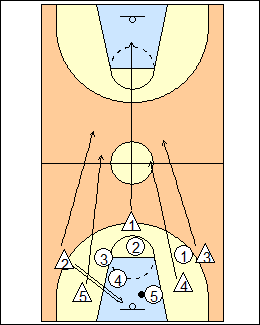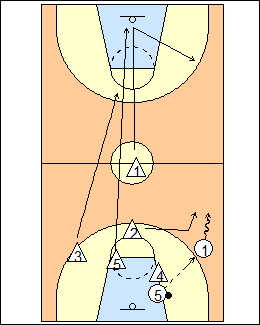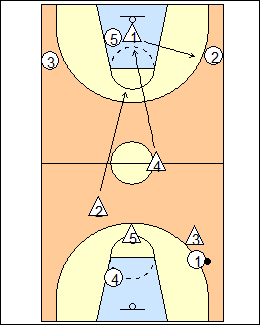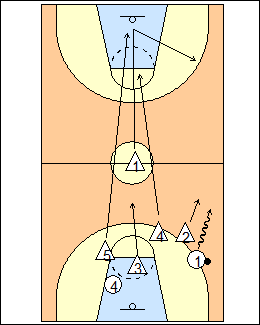Defensive transition
 | 1 The goal of defensive transition is to balance offensive rebounding with getting back to play 5-on-5 halfcourt defence (no layups). With basic transition defence (shown), all attackers crash the boards on a shot, sprint back to the paint on a defensive rebound (while seeing the ball) then pick up their checks. Against a fast-break team, more systematic transition defence can entail - one or more safeties who sprint back on a shot to protect the basket - picking up the ball early to slow it down - jamming the defensive rebounder, delaying an outlet pass - defending the trailer (defensive rebounder) at ball level with the jammer, providing help on the ball - covering the wing area to defend a head-man pass up the sideline. Even greater pressure can be applied by - denying an outlet pass to the point guard, slowing down the break by forcing a pass to another player - trapping on an outlet pass - trapping the defensive rebounder. See below for different approaches to defensive transition, also Defences - Transition basics, BNSW transition, Tall Ferns transition, AIS transition, Match-up press. |
 | 2 coachesclipboard.ca Great defensive teams have a system for defensive transition when their team shoots, not allowing the other team to get layups. Defensive transition entails two critical factors, protecting the basket and slowing down ball advancement. Usually protect the basket by having a guard sprint back to centre on the shot (or have two defenders go back to centre, one on each side). The safety (here 1) does not try to stop the ball being dribbled upcourt in the open court but prevents it from being advanced directly towards the basket. If the safety gets in a 2 on 1, they should stay within one step of the "split line" and try to make the dribbler pull up, e.g., by faking and recovering. Many teams slow the ball down by "jamming the rebounder" to prevent the quick outlet pass; usually the nearest offensive rebounder pressures the ball (here 4). Most teams also have a guard (here 2) defend the player who gets the outlet pass, usually by getting to the top of the key as the shot is taken, then moving quickly on the pass to prevent the receiver from passing or dribbling directly upcourt, try to keep it to the sideline. Remaining defenders sprint back to build the defence. With at least two defenders back, discourage any pass upcourt, usually by the safety after being released from protecting the basket by the first big to get back (the safety yells take the basket). Allison McNeill - send 3, 4 and 5 to the offensive boards (if 2 drives to the basket, 3 goes back). 2 is long safety behind centre or to where the deepest attacker is. As defenders get back and the basket is covered, they move into on the line, up the line positions so the ball cannot be passed easily up the floor. 1 is short safety between the foul line and top of circle, his job is not to steal the ball but pick it up and contain it so the bigs can get back, he tries to get the ball out of the middle. |
 | 3 Ken Shields Defence begins when we shoot the ball, the point guard must rotate to safety, if he drives 2 is safety. The closest man pressures the outlet passer on a miss or the inbounds passer on a make, then supports the on-ball defender against middle penetration by forming a middle triangle between the ball and his man (here 5 is the jammer). The man closest to the outlet side wing fades to the outlet area, tries to make the receiver catch coming back to the ball (don't let him catch and go), contains the dribbler, forces sideline, establish an early strongside (here 3 is the outlet). The other two players are sprinters (4 and 2), the biggest releases the safety and protects the basket, the safety takes the first open man up the sideline. See Tall Ferns transition. Scott Clark - floor balance, 3 goes to the front of the rim on a shot, 4-5 go to either side, 2 sprints to the top of the key and 1 takes the basket. The ball must be slowed by halfcourt, the higher the better. Sprint back to the pack area looking over your inside shoulder to see the ball, match-up. Know attacker names and numbers, in transition you are guarding a man, not your man. Mike McNeill - if you jam the rebounder you must be able to slow the ball down once it gets out. If falling back into a 1/4-court zone defence, he wouldn't mix the two, just sprint back, set up the defence. Basketball Canada - to stop the other team's fast break, options are - have all players sprint back when the ball is lost - designate one or two safeties, usually guards, who do not rebound offensively unless they shoot a layup - one or two players pressure (or have the option to pressure) the defensive rebounder to delay the outlet pass (this can create disadvantage situations if the outlet pass is made) - deny a pass to a primary receiver (point guard), forcing an outlet pass to another player - have a guard pick up the ball at centre and put light pressure on the ball to slow it down. Mike MacKay - there is no deep threat if a team doesn't fast break or always has one player advance the ball, so the defence can jam the rebounder and deny the outlet, although a quick break-out dribble can catch the defence at a disadvantage, and with long rebounds off 3-point shots it is often more difficult to jam. A vulnerable time is when the safety is released by a bigger retreating player, most 3-point shots are due to this not occurring, but releasing too early can leave the basket open for a score at the rim. Teams that fast break move the release point further upcourt, giving themselves more space, and less pressure, as the safety must move further back before moving forward. Ian MacKinnon - they will typically jam the outlet, if there is basket protection he may have the next defenders run back through the outside lanes to disrupt the head-man pass. |
 | 4 Heath Millar Defending the fast break begins on offence with shot selection and floor balance. Long shots create long rebounds, which often means no need for an outlet pass. If the other team is not threatened by your players crashing the boards for offensive rebounds, they will start to leak wing players who don't need to box out. Some coaches send 3-4-5 to the boards, 1 goes deep to protect the basket, 2 patrols for long rebounds but more importantly picks up the outlet pass and aims to slow the dribbler. Once the ball has been outletted 5-4-3 sprint back and ensure that the low help (basket) and high help positions have been filled before matching up. You do not have a player in transition, make sure that the hoop is covered (low help), someone is in high help, and someone is in front of the ballhandler. Other options are a) send four players to rebound, which will speed up the game and make it hard for the other team to outlet pass, but will leave you vulnerable if the other team is organized in transition and can get a quick outlet, b) no offensive rebounders, all players get back to slow down a game, ensuring that you will be very hard to score against in transition, but you will almost never get a second chance to score. Jeff Van Gundy - send two to the glass and three back, you can't do two back in a tandem because of the transition 3 and how every team is sending their wings to the corners. Get back on the motion of the shot, not on the shot. On makes, match to your man (your players are dogs if they can't do this); on misses, match to similar size. Transition defence and offence depend on intelligence of perimeter players and hard work of bigs. A trailing defensive big runs back and makes contact, the trailer's defender sprints ahead of the ball and loads to it. |
 | 5 Kevin Eastman Sprint back, set our defence, be prepared to play in the halfcourt. There are 5 key teaching points - talking, pointing, matching up, loading to the ball, switching if necessary (only on the weakside). We are guarding the other team, find the open man, match up by using our eyes. Call out the first open man that you can get, or point to him, your teammates may not be able to hear you. Loading to the ball means all defenders are strongside or midline (shrink or help position). Switch only on the weakside to get like positions, big on big and small on small. There are two types of transition (fast break) teams, a) pass ahead teams - stop that first pass up the sideline or up the floor, match up to a player (preferably your own) when he reaches halfcourt (we may need to retreat diagonally, rather than a traditional retreat to the lane line then closing back out); b) dribble advance teams (shown) - cover the ball as soon as we can, defenders on the wing attackers get back to the elbows so the point guard doesn't see any gaps or driving lanes. Billy Donovan - 1 is floor balance on a shot unless he drives it, then another designated player must get back. One of the two bigs must get back and bump the safety out to weakside perimeter. Against a good 3-point team you are going to give up 3s if you run back to the paint in transition, fan out, and get a man. With the 3-point line a team with inferior talent can beat a team with superior talent. Avery Johnson - 1, 2, and 3 get back as the shot is taken, 4 and 5 can rebound only if they are close enough to the basket (within about 12 feet). Cover the threats - the basket, the ball (pick it up as early as possible), the right wing, and the left wing. We want numbers, the defender of the trailer does not run back with the trailer, he gets in front of the ball and is the help to contain the ball as it is brought up the floor. Steve Nash - defenders backpedal as they get near the paint, then come out (fan out) to stop the ball. Jab at the ball to force the dribbler to pull up or pass. Don Kelbick - the priorities are basket, ball, man. All five guys sprint back (don't play the ball unless you have a great defender), find the ball and make sure it is covered, then find a man. You may give up some 3s because you are protecting the basket first. If the other team has a great 3-point shooter, make an adjustment to find him in transition. breakthroughbasketball.com - the second the other team gets the ball, your players need to turn, sprint back to the opposite end and find their man. At times they will have to match up, then it's very important to communicate. If the other team has an advantage on the break, sprint back to protect the basket then come out to match up, give up an outside shot rather than a layup. Oliver Purnell - take care of basket, take care of ball, pick up the next most dangerous guy (most likely ballside). Seth Miller - send three to the glass, one guard (fullback) sprints back to the paint, another guard (halfback) sprints to the center circle. Priorities are protect the basket and stop the ball. On an advance pass up the sideline, the fullback moves out to stop the ball while the halfback drops into the paint to protect the basket. If there is no advance pass, the halfback picks up the ball and begins to level off the ballhandler until the rest of the team gets back. Make a triangle with three players back (one picks up the ball, two are on the blocks), be in a tandem with two back. A player behind the ball comes to the top of the key and picks up the closest attacker. Make the game 5 on 5. In transition you must talk, point (if you hate to talk), or be really matched up. |
 | 6 Mike Dunlap A numbered defensive break, each player has the same lane as in the numbered fast break. Pressure the ball while covering fast break lanes. Meet the outlet pass, turn the ball as often as possible, slow it down at least. Sprint the lanes, the first three steps are most important, get below level of the ball. Match up to an attacker in your lane, or to the nearest attacker if none is in your lane. 1 is the free safety, he gets to the initial outlet on a make or miss (or fills the 2 or 3 lane if he can't get to the ball). 2 sprints the right sideline, 3 sprints the left sideline (or they take the outlet pass if 1 can't). 4 sprints an inside lane nearest 3, is responsible for any trailer, will assist on middle penetration if his man is dragging up the court. 5 sprints to the paint, takes the first cutter through the paint. Bill Grier (Gonzaga) - four players go to the boards, 1 is the safety, he goes to centre, they don't jam the rebounder. Herb Brown - contain and pressure the dribbler, stop the ball. The first defender back must retreat to the paint, cover the goal, build the defence out. The first big back picks up the first inside attacker, not necessarily his man. All other defenders must get level with or below ball level, quickly match up with an attacker near the goal and verbally communicate a switch. If your man has been picked up, take the next free man closest to the basket. Establish weakside and ballside help. After the first pass is made, while his teammates are in a tandem, the third player back should go weakside to set up a defensive triangle. It is much more difficult for players to stop the ball and pick up their men against a zone defence, try to get back to ball level. If you can't match up, sprint back, pack the paint, build the defence out from in front of the basket. Lee Rose - the closest man to the outlet passer jams the rebound, getting his hands up to deflect the pass. Contain the receiver of the outlet pass by staying in front of him and not getting beat off the dribble - retreat but don't get beat. Everyone sprints to ball level, giving support to stop dribble penetration, then finds their man. Always see the ball. The big man sprints to the paint, looking to help (show) on dribble penetration. One player protects the basket, if it's the point guard and he attacks the basket, 2 is back, if 1 and 2 end up under the basket, 3 is back. The better your opponent, the fewer people you can send to the offensive boards. Basketball Highway - the most important concept is buying time, a common mistake is gambling to steal or stop the ball in the open court. Defensive transition first consists of defending the basket, the first defender back sprints to the basket area, is the last line of defence, and contains the ball. Most schemes involve getting a sprinter out to discourage a long upcourt pass. Once there are two defenders back (in a tandem), in most cases get back and discourage passing lanes. Force a diagonal dribble any time you are in a position to discourage advancement of the ball directly. Communicate with teammates, say it and point it. In getting back, try to cover players by position, but this is secondary to basket defence and containing the ball, until that is taken care of everyone must sprint back to the basket and locate a player (many teams sprint back to almost zone positions such as 2-2-1 or 3-1-1). When the team is good at getting back, then put a jammer on the rebounder, deny the first outlet receiver, third and fourth defenders can prevent long sideline passes or clog the middle of the court. Get ahead of the ball, try to deflect (backtip) the ball if behind. Always force your opponent to take the lowest percentage shot possible. |
 | 7 Kevin O'Neill - the first man back (here 1) gets under the basket, then closes out - the second man back gets to the foul line, then stops the ball - the third man back takes the unguarded attacker closest to the ball - the fourth man gets to the basket - the fifth man (load man) gets to the foul line. coachesclipboard.net - assign two guards to retreat on the shot, one on each side of the centre circle, the ballside guard picks up the ball, the other retreats to the paint. One of our rebounders should try to "jam" and pressure the defensive rebounder to prevent or slow down the outlet pass, the other two players sprint back to the paint. Ralph Miller - instant conversion from offence to defence and vice versa eliminates any rest that the opponents would get on changes of possession. Use an automatic pick-up rule to control the fast break - guard the man who was guarding you when possession was lost, providing coverage on the rebound, the outlet pass, and as the offence attempts to fill the lanes. Tusculum - two guards get back on the shot, the lane defender sprints back to the paint, the ball defender works to contain the dribble at halfcourt and get it out of the middle (his pick-up point can change depending on the opponents), remaining players sprint back - turn and sprint the first 3 steps, then locate the ball. Pressure the ball, pick up at halfcourt. James Green - hole and ball - the first man back takes the hole (does not leave until a big calls him out), the second takes the ball, the others deny the wings in transition. Steve Witty (FIBA Assist 1) - first priority is the basket, second is the ball, third is to fan out and play defence against shooters that are spotted up. Sagadin (FIBA Assist 14) - sprint back to ball level, stop the ball, be ready to switch everything, bump the trailer (don't allow a direct cut), foul if necessary - no easy basket, no coast to coast. Bob Hurley - getting back in transition is so important that he is willing to be a bad offensive-rebounding team if it means his players are sprinting back. He doesn't believe in jamming the rebounder because he wants running to be instinctive at the very moment the defence controls the rebound. They will deny the outlet with the point guard to force the other primary ballhandler to come back to receive the ball. On a score, the defender guarding the inbounder will double the point guard to deny an inbounds pass to him. It is advantageous if you can put a tall guard on the opposing point guard because he can sprint to the defensive board without worrying about box out as the opposing point guard sprints back to protect deep. With the other four defenders boxing out, this can really control the glass. If you have a talented post who can put it on the floor, allow him to bust it out on the break rather than throwing the outlet, this will invert the defence and cause plenty of match-up problems. |
This page was made with Basketball playbook from Jes-Soft

